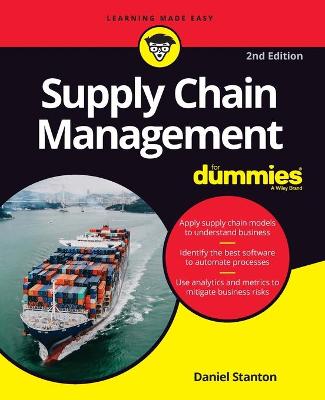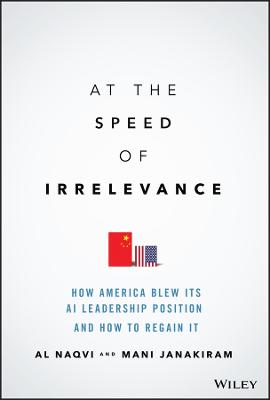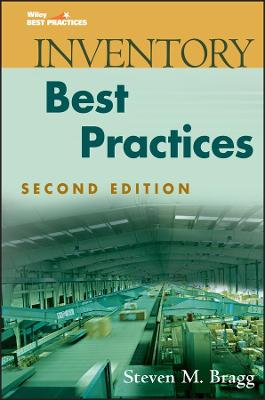Supply Chain Management For Dummies 2e
 -15%
portes grátis
-15%
portes grátis
Supply Chain Management For Dummies 2e
John Wiley & Sons Inc
02/2021
368
Mole
Inglês
9781119677017
15 a 20 dias
486
Descrição não disponível.
Introduction 1 About This Book 1 Foolish Assumptions 1 Icons Used in This Book 2 Where to Go from Here 2 Part 1: Getting Started with Supply Chain Management 5 Chapter 1: The Growing Demand for Supply Chain Management 7 Defining Supply Chain Management 7 Exploring Complex Business Challenges 9 Operating Under Supply Chain Management Principles 11 Customer focus 12 Systems thinking 12 Bimodal innovation 12 Collaboration 13 Flexibility 13 Technology 14 Global perspective 14 Risk management 14 Visibility 15 Value creation 15 Introducing Five Supply Chain Tasks 15 Implementing the New Supply Chain Agenda 16 Placing the right people in the right jobs 17 Putting the right technology in place 17 Focusing on internal collaboration 17 Directing external collaboration 18 Applying project management 18 Chapter 2: Understanding Supply Chains from Different Perspectives 19 Managing Supply Chain Flows 19 Synchronizing Supply Chain Functions 20 Purchasing 21 Logistics 22 Operations 23 Connecting Supply Chain Communities 23 Designing Supply Chain Systems 26 Measuring Supply Chain Processes 29 Chapter 3: Digging into Your Supply Chain 31 Prioritizing Supply Chain Goals 31 Step 1: Understand what customers value 31 Step 2: Recognize your competitors 33 Step 3: Understand your products or services 33 Looking at Cost Drivers 35 Procurement costs 35 Transportation costs 36 Inventory costs 36 Quality costs 36 Dealing with Trade-Offs 37 Sales versus operations 37 Customer versus supplier 40 Engineering versus procurement 40 Inventory versus customer service 41 Inventory versus downtime 43 Procurement versus logistics 44 Chapter 4: Optimizing Your Supply Chain 47 Designing Your Network 47 Improving and Innovating Processes 49 Lean 49 Six Sigma 51 Theory of Constraints 53 Structuring Supply Chain Projects 55 Managing cross-functional project teams 55 Creating cross-functional project plans 56 Creating a RACI matrix 59 Designing project scorecards 60 Using the DIRECT model 61 Part 2: Managing Supply Chain Processes 65 Chapter 5: Connecting Supply Chain Processes 67 Introducing the SCOR Model 68 Establishing Process Metrics 72 Building the Right Supply Chain 73 Chapter 6: Planning the Supply Chain 75 Balancing Supply and Demand 76 Aligning Resources with Requirements 77 Analyzing Your Customers 79 Planning Your Products 80 Planning Your Production Systems 81 Planning Your Delivery Systems 82 Planning for Returns 83 Chapter 7: Sourcing, Purchasing, and Procurement 85 Understanding Strategic Sourcing 86 Segmenting Your Supply Chain 86 Managing Life Cycle Costs 88 Minimizing input costs 89 Sourcing your inputs 90 Forecasting your demand 92 Insourcing, outsourcing, and offshoring 92 Managing Supplier Relationships 93 Managing Procurement Processes 95 Establishing Supply Contracts 95 Selecting contract terms 96 Selecting payment terms 97 Mitigating Supplier Risks 99 Dealing with risks 100 Deciding which risks to manage 100 Implementing supplier development 103 Increasing supplier diversity 103 Establishing Purchasing Ethics 104 Sustainable Sourcing 105 Chapter 8: Making Your Products or Services 107 Planning and Scheduling Production 108 Planning production 108 Considering capacity 112 Identifying Manufacturing Process Types 114 Operating a discrete manufacturing process 115 Operating a continuous manufacturing process 117 Choosing Your Production Environment 117 Make-to-stock 118 Make-to-order 119 Engineer-to-order 121 Implementing Quality Control and Quality Assurance 121 Considering the risks of poor quality 121 Controlling quality and variability 122 Reducing Manufacturing Waste 124 Chapter 9: Delivering Your Products or Services 127 Understanding Modes of Transportation 128 Pipeline 129 Cargo ship 129 Rail 129 Truck 131 Parcel 133 Air 133 Selecting Modes of Transportation 134 Managing Warehousing and Inventory 136 Receiving 138 Put-away 138 Inventory counts 138 Picking 139 Packing 139 Shipping 140 Yard management 141 Over, short, and damaged 141 Establishing Inventory Ordering Policies 142 Selecting Material Handling Equipment 143 Managing and Filling Orders 145 Maintaining Visibility of Shipments 147 Leveraging Third-Party Logistics 148 Optimizing Freight Audit and Payment 149 Chapter 10: Managing Product Returns and Reverse Supply Chains 151 Growing Revenue with Easy Returns 151 Processing Returns of New or Excess Products 153 Minor wear and tear 154 Damage or tampering 154 Substitution 154 Processing Returns of Used or Defective Products 155 Managing Closed-Loop Supply Chains 155 Handling Unauthorized Returns and Fraudulent Products 156 Managing Trade-Ins 157 Chapter 11: Enabling Your Supply Chain 159 Managing Your Business Rules 159 Managing Supply Chain Performance 160 Setting performance goals 161 Align your metrics with your customers 161 Share your metrics with your suppliers 162 Managing Your Assets 162 Labeling Your Products 164 Preventing Tampering 166 Addressing Supply Chain Security Issues 166 Ensuring physical security 166 Dealing with counterfeiting 167 Tackling regulatory compliance 168 Addressing unique product requirements 168 Protecting supply chain information 170 Leveraging Information Technology 170 Leveraging Human Resources 171 Mastering Project Management 174 Part 3: Using Technology to Manage Supply Chains 177 Chapter 12: Managing Supply Chain Software 179 Understanding How Processes Evolve 180 Using Transportation Management Systems 182 Using Electronic Load Boards 184 Using Warehouse Management and Execution Systems 185 Using Demand Planning Systems 187 Using Material Requirements Planning Systems 188 Using Manufacturing Execution Systems 190 Using Distribution Requirements Planning Systems 191 Using Labor Management Systems 192 Using Customer Relationship Management Systems 193 Using Supplier Relationship Management Systems 194 Using Enterprise Resources Planning Systems 195 Using Supply Chain Modeling Software 196 Using Business Intelligence Software 198 Leveraging Software Analysts 199 Anticipating the Future of Supply Chain Software 201 Chapter 13: Integrating Advanced Manufacturing into Your Supply Chain 203 Avoiding Obsolescence 204 Preparing for Industry 4.0 205 Capitalizing on Advanced Manufacturing 206 Automated manufacturing 206 Computer-aided design 207 3D printing 207 Automated Mobile Robots 210 Unmanned and Autonomous Vehicles 212 Chapter 14: Managing Digital Supply Chains 215 Digitalizing Products and Services 216 Integrating Planning, Execution, and Visibility 217 Creating Customer Centricity 218 Sharing with Blockchains 219 Harnessing the Internet of Things, Big Data, and the Cloud 220 Connecting with Social Media 222 Employing Artificial Intelligence 222 Preparing for Quantum Computers 223 Retooling for Omnichannel 223 Part 4: Driving Value with Supply Chain Management 225 Chapter 15: Transforming Your Supply Chain 227 Improving Transparency and Visibility 227 Deploying Demand Shaping 228 Performing Postponement 229 Renewing Regional Sourcing 230 Reducing Stock-Keeping Units 231 Optimizing Inventory 232 Incorporating Vendor-Managed Inventory 234 Adjusting Payment Terms 235 Using Supply Chain Finance 236 Controlling the Bullwhip Effect 237 Sharing information with your partners 238 Reducing and aligning lot sizes 238 Managing promotions 238 Starting with Small Improvements 239 Creating Sandboxes 240 Investing in Innovation 241 Chapter 16: Adopting Supply Chain Metrics 243 Understanding Metrics 243 Identifying Performance Attributes 245 Understanding SCOR Metrics 246 Reliability 246 Responsiveness 247 Agility 247 Cost 248 Asset management efficiency 248 Optimizing Operational Metrics 249 Supplier metrics 249 Procure to pay metrics 249 Customer service metrics 249 Capacity, throughput, and yield metrics 250 Formalizing Financial Metrics 251 Accounts payable metrics 251 Total spend metrics 252 Savings metrics 252 Perfecting People Metrics 253 Engagement metrics 253 Productivity and efficiency metrics 253 Turnover metrics 254 Safety metrics 254 Solidifying Sustainability Metrics 255 Consumption metrics 255 Waste metrics 256 Chapter 17: Managing Supply Chain Risks 259 Challenging Assumptions about the Future 259 Building Supply Chain Resilience 261 Identifying Risks 262 Classifying Risks 264 Scoring Risks 265 Managing Risks 267 Accepting the risk 267 Transferring the risk 268 Avoiding the risk 268 Mitigating the risk 268 Handling a Crisis 269 Chapter 18: Building Supply Chain Analytics 271 The Rise of Big Data, Sensors, and the Internet of Things 272 Outline of an Analytics Plan 273 Define your theory of the problem or opportunity 273 Acquire relevant data 274 Clean, structure, and filter the data 275 Query the data and test your theory 275 Look for correlations and patterns 276 Correlation, Causation, and Interpolation 276 Modeling, Simulation, and Optimization 280 Simulation 280 Optimization 281 Scenario Planning 281 Scorecards, Dashboards, and Control Towers 283 Part 5: Building Your Supply Chain Management Career 287 Chapter 19: Selecting a Supply Chain Career 289 Doing Your Homework 289 Examining Supply Chain Career Categories 290 Associates 293 Technicians 295 Planners and analysts 297 Engineers 298 Supervisors 299 Managers 300 Sales representatives 302 Information technology managers 303 Project managers 304 Executives 304 Journalists 305 Educators 305 Humanitarian supply chain professionals 306 Chapter 20: Pursuing Supply Chain Education 307 Earning Certificates and Certifications 307 APICS certifications from the Association for Supply Chain Management 308 Council of Supply Chain Management Professionals 311 Institute for Supply Management 312 The International Society of Logistics (SOLE) 314 Project Management Institute 314 The Futurist Institute 315 International certifications 316 Earning Degrees and Diplomas 317 Undergraduate degrees 317 Graduate degrees 318 Exploring Online Education Options 318 Traditional online programs 319 MITx MicroMasters in Supply Chain Management 319 Arizona State University Online MS-SCM 319 Coursera 320 LinkedIn Learning 320 YouTube 320 Playing Supply Chain Games 321 The Beer Game 321 The Fresh Connection 322 Rise of Industry 322 Following Supply Chain Media 323 Part 6: The Part of Tens 325 Chapter 21: Ten Questions to Ask about Your Supply Chain 327 Who Are Your Key Customers? 327 What Do Your Key Customers Value? 328 How Could Your Supply Chain Create More Value? 328 How Do You Define Supply Chain Management? 329 What Information Do You Share with Suppliers? 329 How Do You Compare with Competitors? 330 What Changes Could Increase Revenue? 331 What Changes Could Lower Costs? 331 What Affects Your Supply Chain Now? 332 What Will Affect Your Supply Chain in the Future? 333 Index 335
Este título pertence ao(s) assunto(s) indicados(s). Para ver outros títulos clique no assunto desejado.
supply chain management; supply chain engineering; logistics; distribution; operations; manufacturing; supply chain certification; SCOR model; Supply Chain Operations Reference model; what a supply chain is
Introduction 1 About This Book 1 Foolish Assumptions 1 Icons Used in This Book 2 Where to Go from Here 2 Part 1: Getting Started with Supply Chain Management 5 Chapter 1: The Growing Demand for Supply Chain Management 7 Defining Supply Chain Management 7 Exploring Complex Business Challenges 9 Operating Under Supply Chain Management Principles 11 Customer focus 12 Systems thinking 12 Bimodal innovation 12 Collaboration 13 Flexibility 13 Technology 14 Global perspective 14 Risk management 14 Visibility 15 Value creation 15 Introducing Five Supply Chain Tasks 15 Implementing the New Supply Chain Agenda 16 Placing the right people in the right jobs 17 Putting the right technology in place 17 Focusing on internal collaboration 17 Directing external collaboration 18 Applying project management 18 Chapter 2: Understanding Supply Chains from Different Perspectives 19 Managing Supply Chain Flows 19 Synchronizing Supply Chain Functions 20 Purchasing 21 Logistics 22 Operations 23 Connecting Supply Chain Communities 23 Designing Supply Chain Systems 26 Measuring Supply Chain Processes 29 Chapter 3: Digging into Your Supply Chain 31 Prioritizing Supply Chain Goals 31 Step 1: Understand what customers value 31 Step 2: Recognize your competitors 33 Step 3: Understand your products or services 33 Looking at Cost Drivers 35 Procurement costs 35 Transportation costs 36 Inventory costs 36 Quality costs 36 Dealing with Trade-Offs 37 Sales versus operations 37 Customer versus supplier 40 Engineering versus procurement 40 Inventory versus customer service 41 Inventory versus downtime 43 Procurement versus logistics 44 Chapter 4: Optimizing Your Supply Chain 47 Designing Your Network 47 Improving and Innovating Processes 49 Lean 49 Six Sigma 51 Theory of Constraints 53 Structuring Supply Chain Projects 55 Managing cross-functional project teams 55 Creating cross-functional project plans 56 Creating a RACI matrix 59 Designing project scorecards 60 Using the DIRECT model 61 Part 2: Managing Supply Chain Processes 65 Chapter 5: Connecting Supply Chain Processes 67 Introducing the SCOR Model 68 Establishing Process Metrics 72 Building the Right Supply Chain 73 Chapter 6: Planning the Supply Chain 75 Balancing Supply and Demand 76 Aligning Resources with Requirements 77 Analyzing Your Customers 79 Planning Your Products 80 Planning Your Production Systems 81 Planning Your Delivery Systems 82 Planning for Returns 83 Chapter 7: Sourcing, Purchasing, and Procurement 85 Understanding Strategic Sourcing 86 Segmenting Your Supply Chain 86 Managing Life Cycle Costs 88 Minimizing input costs 89 Sourcing your inputs 90 Forecasting your demand 92 Insourcing, outsourcing, and offshoring 92 Managing Supplier Relationships 93 Managing Procurement Processes 95 Establishing Supply Contracts 95 Selecting contract terms 96 Selecting payment terms 97 Mitigating Supplier Risks 99 Dealing with risks 100 Deciding which risks to manage 100 Implementing supplier development 103 Increasing supplier diversity 103 Establishing Purchasing Ethics 104 Sustainable Sourcing 105 Chapter 8: Making Your Products or Services 107 Planning and Scheduling Production 108 Planning production 108 Considering capacity 112 Identifying Manufacturing Process Types 114 Operating a discrete manufacturing process 115 Operating a continuous manufacturing process 117 Choosing Your Production Environment 117 Make-to-stock 118 Make-to-order 119 Engineer-to-order 121 Implementing Quality Control and Quality Assurance 121 Considering the risks of poor quality 121 Controlling quality and variability 122 Reducing Manufacturing Waste 124 Chapter 9: Delivering Your Products or Services 127 Understanding Modes of Transportation 128 Pipeline 129 Cargo ship 129 Rail 129 Truck 131 Parcel 133 Air 133 Selecting Modes of Transportation 134 Managing Warehousing and Inventory 136 Receiving 138 Put-away 138 Inventory counts 138 Picking 139 Packing 139 Shipping 140 Yard management 141 Over, short, and damaged 141 Establishing Inventory Ordering Policies 142 Selecting Material Handling Equipment 143 Managing and Filling Orders 145 Maintaining Visibility of Shipments 147 Leveraging Third-Party Logistics 148 Optimizing Freight Audit and Payment 149 Chapter 10: Managing Product Returns and Reverse Supply Chains 151 Growing Revenue with Easy Returns 151 Processing Returns of New or Excess Products 153 Minor wear and tear 154 Damage or tampering 154 Substitution 154 Processing Returns of Used or Defective Products 155 Managing Closed-Loop Supply Chains 155 Handling Unauthorized Returns and Fraudulent Products 156 Managing Trade-Ins 157 Chapter 11: Enabling Your Supply Chain 159 Managing Your Business Rules 159 Managing Supply Chain Performance 160 Setting performance goals 161 Align your metrics with your customers 161 Share your metrics with your suppliers 162 Managing Your Assets 162 Labeling Your Products 164 Preventing Tampering 166 Addressing Supply Chain Security Issues 166 Ensuring physical security 166 Dealing with counterfeiting 167 Tackling regulatory compliance 168 Addressing unique product requirements 168 Protecting supply chain information 170 Leveraging Information Technology 170 Leveraging Human Resources 171 Mastering Project Management 174 Part 3: Using Technology to Manage Supply Chains 177 Chapter 12: Managing Supply Chain Software 179 Understanding How Processes Evolve 180 Using Transportation Management Systems 182 Using Electronic Load Boards 184 Using Warehouse Management and Execution Systems 185 Using Demand Planning Systems 187 Using Material Requirements Planning Systems 188 Using Manufacturing Execution Systems 190 Using Distribution Requirements Planning Systems 191 Using Labor Management Systems 192 Using Customer Relationship Management Systems 193 Using Supplier Relationship Management Systems 194 Using Enterprise Resources Planning Systems 195 Using Supply Chain Modeling Software 196 Using Business Intelligence Software 198 Leveraging Software Analysts 199 Anticipating the Future of Supply Chain Software 201 Chapter 13: Integrating Advanced Manufacturing into Your Supply Chain 203 Avoiding Obsolescence 204 Preparing for Industry 4.0 205 Capitalizing on Advanced Manufacturing 206 Automated manufacturing 206 Computer-aided design 207 3D printing 207 Automated Mobile Robots 210 Unmanned and Autonomous Vehicles 212 Chapter 14: Managing Digital Supply Chains 215 Digitalizing Products and Services 216 Integrating Planning, Execution, and Visibility 217 Creating Customer Centricity 218 Sharing with Blockchains 219 Harnessing the Internet of Things, Big Data, and the Cloud 220 Connecting with Social Media 222 Employing Artificial Intelligence 222 Preparing for Quantum Computers 223 Retooling for Omnichannel 223 Part 4: Driving Value with Supply Chain Management 225 Chapter 15: Transforming Your Supply Chain 227 Improving Transparency and Visibility 227 Deploying Demand Shaping 228 Performing Postponement 229 Renewing Regional Sourcing 230 Reducing Stock-Keeping Units 231 Optimizing Inventory 232 Incorporating Vendor-Managed Inventory 234 Adjusting Payment Terms 235 Using Supply Chain Finance 236 Controlling the Bullwhip Effect 237 Sharing information with your partners 238 Reducing and aligning lot sizes 238 Managing promotions 238 Starting with Small Improvements 239 Creating Sandboxes 240 Investing in Innovation 241 Chapter 16: Adopting Supply Chain Metrics 243 Understanding Metrics 243 Identifying Performance Attributes 245 Understanding SCOR Metrics 246 Reliability 246 Responsiveness 247 Agility 247 Cost 248 Asset management efficiency 248 Optimizing Operational Metrics 249 Supplier metrics 249 Procure to pay metrics 249 Customer service metrics 249 Capacity, throughput, and yield metrics 250 Formalizing Financial Metrics 251 Accounts payable metrics 251 Total spend metrics 252 Savings metrics 252 Perfecting People Metrics 253 Engagement metrics 253 Productivity and efficiency metrics 253 Turnover metrics 254 Safety metrics 254 Solidifying Sustainability Metrics 255 Consumption metrics 255 Waste metrics 256 Chapter 17: Managing Supply Chain Risks 259 Challenging Assumptions about the Future 259 Building Supply Chain Resilience 261 Identifying Risks 262 Classifying Risks 264 Scoring Risks 265 Managing Risks 267 Accepting the risk 267 Transferring the risk 268 Avoiding the risk 268 Mitigating the risk 268 Handling a Crisis 269 Chapter 18: Building Supply Chain Analytics 271 The Rise of Big Data, Sensors, and the Internet of Things 272 Outline of an Analytics Plan 273 Define your theory of the problem or opportunity 273 Acquire relevant data 274 Clean, structure, and filter the data 275 Query the data and test your theory 275 Look for correlations and patterns 276 Correlation, Causation, and Interpolation 276 Modeling, Simulation, and Optimization 280 Simulation 280 Optimization 281 Scenario Planning 281 Scorecards, Dashboards, and Control Towers 283 Part 5: Building Your Supply Chain Management Career 287 Chapter 19: Selecting a Supply Chain Career 289 Doing Your Homework 289 Examining Supply Chain Career Categories 290 Associates 293 Technicians 295 Planners and analysts 297 Engineers 298 Supervisors 299 Managers 300 Sales representatives 302 Information technology managers 303 Project managers 304 Executives 304 Journalists 305 Educators 305 Humanitarian supply chain professionals 306 Chapter 20: Pursuing Supply Chain Education 307 Earning Certificates and Certifications 307 APICS certifications from the Association for Supply Chain Management 308 Council of Supply Chain Management Professionals 311 Institute for Supply Management 312 The International Society of Logistics (SOLE) 314 Project Management Institute 314 The Futurist Institute 315 International certifications 316 Earning Degrees and Diplomas 317 Undergraduate degrees 317 Graduate degrees 318 Exploring Online Education Options 318 Traditional online programs 319 MITx MicroMasters in Supply Chain Management 319 Arizona State University Online MS-SCM 319 Coursera 320 LinkedIn Learning 320 YouTube 320 Playing Supply Chain Games 321 The Beer Game 321 The Fresh Connection 322 Rise of Industry 322 Following Supply Chain Media 323 Part 6: The Part of Tens 325 Chapter 21: Ten Questions to Ask about Your Supply Chain 327 Who Are Your Key Customers? 327 What Do Your Key Customers Value? 328 How Could Your Supply Chain Create More Value? 328 How Do You Define Supply Chain Management? 329 What Information Do You Share with Suppliers? 329 How Do You Compare with Competitors? 330 What Changes Could Increase Revenue? 331 What Changes Could Lower Costs? 331 What Affects Your Supply Chain Now? 332 What Will Affect Your Supply Chain in the Future? 333 Index 335
Este título pertence ao(s) assunto(s) indicados(s). Para ver outros títulos clique no assunto desejado.




